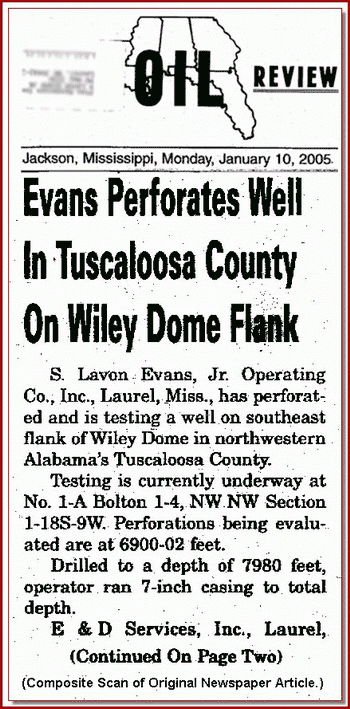Seisma Oil Research, LLC Introduces The 5th In A Series of Vintage News Reports on Their Exclusive Drilling Partner Evans Energy (E2)
Press release March 27, 2009 Energy & EnvironmentKnowing how to properly perforate a well casing in order to extarct the greatest amount of hydrocarbon product with ease is not a simple process. Seisma Oil Research, LLC's industry partner, Evans Energy (E2), has been performing this type of highly skilled work for a long time.

Boca Raton, FL, March 27, 2009 -- Knowing how to properly perforate a well casing in order to extarct the greatest amount of hydrocarbon product with ease is not a simple process. Seisma Oil Research, LLC's http://www.seismaresearch.com/ industry partner, Evans Energy (E2) http://www.evansenergyonline.com/, has been performing this type of highly skilled work for a long time. The vintage article shown here, from January 10, 2005, describes just one of over 400 hundred perforation tests that Evans has performed over the years.
Relative to oil wells a perforation refers to a hole or series of holes that are punched in the casing or liner of an oil well to connect it to the reservoir. In cased hole completions, the well is drilled beyond the section of the formation that is targeted for production and will have casing or a liner run in segregating the formation from the well bore itself. The final stage of the completion then involves running in the chosen type of perforating equipment down to the desired depth and perforating the casing or liner.
Perforating is the most common form of well stimulation. It's a process in which charges are shot into the formation through pipe so that hydro carbons can more easily flow back into the production tube. It also allows the driller to "frac" the formations. That means using acid and other chemicals to open up the formation so that extraction will be easier. Both processes, perforating and fracing were and still are used by Lavon Evans and his crews.
Commonly, perforation guns are run on E-line as it is traditional to use electrical signals from the surface to fire the guns. In more highly deviated wells, coiled tubing may be used. Newer technologies allow the guns to be run on slickline. No communication with the surface is possible with slickline. Instead, a mechanism on the gun arms the charges upon reaching a certain temperature and pressure. A timer will then fire them following a set interval.
The benefit of this strategy is greater deal of control of the well. Casing the bottom of the hole allows the well to be completed without having to worry about reservoir fluids. It also allows precise selection of where in the formation production will be and to be able to seal off perforations, which are no longer useful or counterproductive, through cementing or straddling. The disadvantage is that perforating can lead to "skin damage", where debris from the perforations can hinder productivity of the well. In order to mitigate this, perforating is commonly done underbalanced(lower pressure in the well bore than in the formation) as the higher formation pressure will cause a surge of fluids into the well at the point of perforating, hopefully carrying the debris with it. Other methods of stimulation such as acidising and proppant fracturing are often required to overcome this damage and bring the well up to its full potential.
Casing and perforating as a method of completion is common place nowadays, though in some unconsolidated formations, prone to production of sand, open hole completions, using only sandscreens, may be the preferred choice.
Seisma Oil Research, LLC
433 Plaza Real
Suite 275
Boca Raton, FL 33432
USA Phone: 561.962.4288
Fax: 561.962.4101
SOR"S Secure Web-based Form For Inquires and Contact: https://www.seismaresearch.com/contact/index.html
This press release / email may include forward-looking statements as defined by the Securities and Exchange Commission. Such statements are those concerning forecasts, estimates, expectations and objectives for future operations. Such statements are subject to a number of assumptions, risks and uncertainties, many of which are beyond the control of the company. Statements regarding future production, reserve additions and capital expenditures are subject to all of the risks and uncertainties normally incident to the exploration for and development and production of oil and gas. These risks include, but are not limited to, inflation or lack of availability of goods and services, environmental risks, drilling risks and regulatory changes. Investors are cautioned that any such statements are not guarantees of future performance and that the actual results, or developments, may differ materially from those projected in the forward-looking statements. The above mentioned program has been fully funded and is not available to new investors.
###
Subjects
Energy & Environment

 Follow
Follow